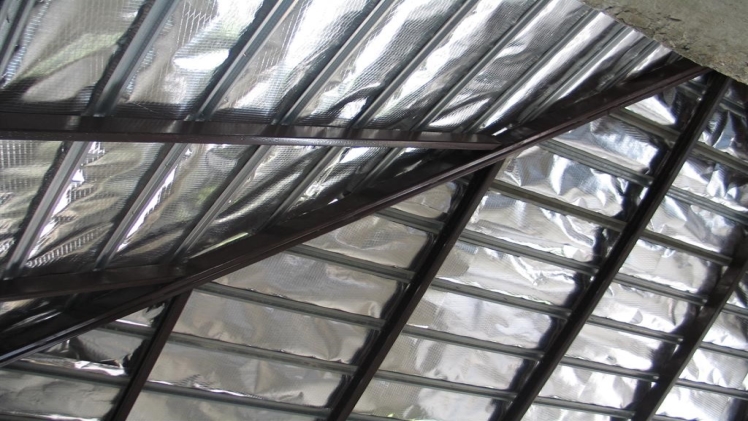type of construction material building a house บริษัทรับสร้างบ้าน A protective material must be built around the building with a thermal resistance of building materials (R). The R-value of some materials not specified. The value may be obtained from the material manufacturer.
- This R value represents the difference in temperature of the two sides of the material to be heated to the other side of the material in a unit area of the material. with 1 unit of heat per hour R = Fº /Btu/hr × sf
- Rt is the total resistance of the material at that thickness.
- U is the heat transfer rate of the material of that total thickness. The value is expressed as the transfer rate per unit area of material with a temperature difference of 1 degree on both sides.
- The U-value of the material is inversely proportional to the R of that material U = 1/Rt
- Q is the total amount of heat transmitted through any material, equal to U × A × (ti – to), where :
U is the heat transfer rate through the overall thickness.
A is the area where the surface is exposed to heat.
(ti – to) is the temperature difference between the two sides of the material.
Insulation material
Materials used at home building companies รับสร้างบ้าน Most of the construction has a heat resistance in itself part already. But in order for the walls, resurrection and roof to reach the required Rt (heat resistance) values, insulating material must be added to the walls, floors and roofs. An effective insulating material takes the form of filling air pockets inside.
- Soft form is made up of flexible fiber insulation materials such as glass fibers, synthetic fibers. It is composed of sheets of various thicknesses, lengths and widths of 16″ or 24″ (406 or 610), used for trusses, joists and rafters for wooden building structures. Sometimes there are anti-evaporation sheets, foil sheets, plastic sheets to cover the face. This type of insulation is also considered sound insulation.
- Solid sheets are pre-formed from the factory. It looks like a solid sheet made of foam plastic. or cellular glass Cellular insulators are fire resistant. Resists moisture through and retains its shape but has a lower heat resistance than foam plastic But the foam plastic will ignite. Therefore, it is necessary to use it together with the fireproof sheet. Rigid insulation has a closed-shell texture similar to extruded polystyrene foam) and honeycomb. (Cellular glass) is moisture resistant and can be placed in contact with the soil.
- Foam injection form Applications can be made by spraying plastic foam such as polyurethane onto the surface of the building that is attached to the exterior.
- Small fragments, consisting of vermiculide filaments. (a type of heat insulating material) perlite or special cellulose fiber Operate by pouring into the cavity by hand or with a nozzle.
- Heat reflective sheets such as foil or sheets with high reflective properties that may be used in conjunction with gypsum board. and provide air gaps to reduce heat transfer by radiationVisit Here: wcowlnews
In addition to calculating the rate of heat loss or absorption To be considered as the total thermal resistance (R_t) of the materials that are assembled into various parts. of the said building There are other factors affecting the loss and absorption of heat of a building as follows:
- Color and heat reflection of the valdu skin. Light and shiny colors tend to be more reflective than dark and matte.
- The total mass of building components, which affects the duration of heat absorption, heat dissipation, and has a strong effect on thick and dense materials.
- Is the orientation of the building appropriate for the direction of sunlight and wind blowing into the building?
- Latent heat generated within the building itself, such as from residents, lighting and electrical equipment.
- How to install the insulation and moisture barrier correctly.read more : expressdigest
35. Installation of floor and roof insulation
concrete floor
- Decorative surface covering over insulating solid sheets.
- Wood edge
- Lightweight concrete insulation. Crab topcoat is a decorative surface in the body.
concrete roof
- At least ¼/in/ft (1:50) sloped surface for drainage.
- Waterproof layer is laid over a rigid insulator.
- Reinforced with rigid insulation (if necessary).
steel floor
- Lining boards have some degree of insulation.
- Aerated concrete insulation poured over the steel roof.
steel roof
- Pour over with lightweight concrete or slabs. Prefabricated wood pulp mixed with cement and built-in insulation.
- Install rigid insulation such as At least two pieces for the steel roof background.
- The underside of the roof may be sprayed with foam insulation.
- Install rigid insulation.
wooden floor
- Flexible insulation is installed between the floor joists.
- Decorative surface covering the insulator with a hard sheet.
- In the event that a moisture barrier is required to be installed It must be installed on the hotter side.
- Wood edge
wooden roof
- Install rigid insulation under the roofing sheet.
- Leave at least 1″ (25) gap for ventilation.
- Soft insulation.
- Lining plank roof background. Don’t hit the ceiling.
- The roof fixings must be of sufficient length to penetrate through the roof and insulation to secure the roof roof.

